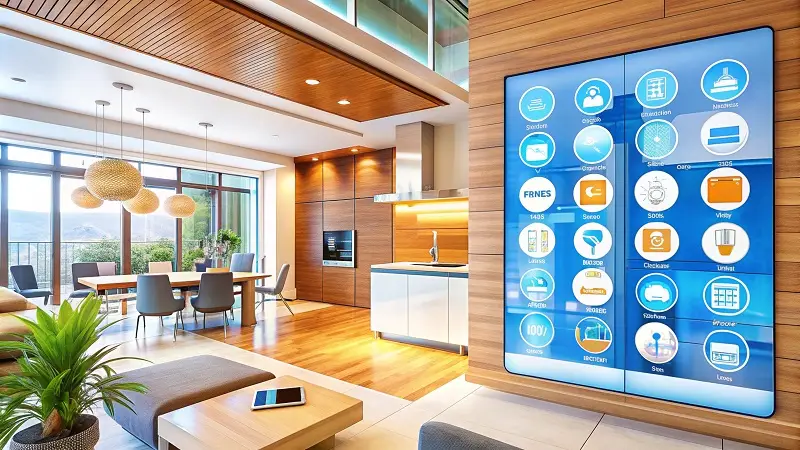Key Takeaways
- Smart home technology enhances convenience, energy efficiency, and security for homeowners.
- The integration of AI and IoT devices offers deeply personalized and automated environments tailored to individual preferences and routines.
- Smart home adoption is expanding rapidly, fueling robust growth in the home technology market.
Across the country, the adoption of smart home technology is revolutionizing how residents experience daily life. With features designed to optimize convenience, comfort, and security, the modern home has transformed into an intelligent hub where automation simplifies everything from climate control to entertainment. As the market evolves, homeowners are now turning to home building companies in Oklahoma City for the seamless integration of these high-tech solutions.
Smart homes don’t just offer luxury—they deliver practical, everyday benefits that appeal to a broad spectrum of buyers. Automated lighting, energy-efficient appliances, and AI-driven voice assistants are no longer exclusive to tech enthusiasts. Instead, they are becoming standard features in new homes, driven by a desire for increased efficiency, improved personalization, and better security for families and individuals alike.
One of the biggest appeals of smart home technology is its ability to respond to user needs almost instantly. Whether managing the indoor climate or securing the premises with remote monitoring, today’s homeowners are empowered by intuitive control and automation. The evolution of home living continues to accelerate, and with it, the expectations for what a modern home can and should do are being redefined.
For those considering an upgrade or new construction, understanding the growing role of smart technology in residential living is essential. These systems not only boost property value but also support sustainability objectives and improve the quality of life. For more information on industry innovations, platforms such as the Department of Energy’s Energy Saver offer valuable insights into product performance and trends.
Enhancing Convenience with Automation
Home automation is at the heart of smart technology’s promise to make life easier. Devices like smart thermostats learn your schedule, automatically adjusting the temperature to save energy when you’re away and maximize comfort when you’re home. Voice-activated assistants, such as Amazon Alexa and Google Assistant, enable hands-free control of various devices, including lights and music playlists. These tools let users manage multiple aspects of their household through simple voice commands or intuitive apps, streamlining daily routines and reducing manual effort.
Boosting Energy Efficiency
Environmental consciousness and cost-saving go hand in hand with smart home systems. Smart appliances and meters provide real-time updates on resource consumption, enabling families to identify opportunities for savings. For example, intelligent washing machines and dishwashers can delay their cycles until off-peak hours, minimizing strain on the grid and lowering utility bills. According to the U.S. Department of Energy, smart thermostats alone can cut home heating and cooling costs by 10–12% annually just by optimizing use based on real-time occupancy data.
Strengthening Home Security
Today’s smart security solutions protect homes with advanced capabilities previously only available in commercial-grade setups. AI-powered cameras can distinguish familiar faces from strangers, while smart locks provide keyless entry and generate real-time notifications whenever your door is accessed. Motion-triggered floodlights, window sensors, and remote-access alarm systems offer peace of mind to homeowners both at home and on the go. These tools not only deter potential intruders but also enable residents to verify visitors and remotely monitor deliveries, further enhancing convenience and safety.
Personalized Living Experiences
Personalization is becoming a hallmark of the modern smart home. Machine learning algorithms enable home assistants to recognize individual voices, tailoring responses and automations to each family member. From setting mood lighting based on personal preferences to adjusting entertainment options according to who’s in the room, smart systems can deliver custom-tailored living experiences. Even kitchen technology is evolving, with appliances suggesting recipes based on available ingredients or dietary preferences.
Market Growth and Adoption
The market for smart home devices is surging as adoption rates climb year over year. According to industry reports, over 40% of U.S. internet-connected households now own at least one smart device, and the average household connects more than 18 devices, ranging from smart speakers to security systems. Analysts attribute this rapid growth to increasing consumer awareness and the rising affordability of core devices, with smart lighting, security cameras, and climate controls among the most sought-after features.
Future Trends in Smart Home Technology
The next wave of smart home innovation is already underway, powered by advancements in 5G connectivity and artificial intelligence. As high-speed networks enable more stable and expansive connections, device interoperability will improve, creating truly integrated home ecosystems. AI enhancements are poised to make home assistants even more proactive, anticipating needs and suggesting automations long before homeowners make a manual request. According to the U.S. Department of Energy, these trends reflect a shift from reactive to predictive smart home environments, further streamlining daily life and boosting user satisfaction.
Conclusion
Smart home technology is fundamentally reshaping residential living by prioritizing convenience, energy conservation, security, and personalization. As adoption accelerates and the technology continues to mature, homeowners will benefit from more nimble and responsive living spaces. Choosing to incorporate smart features is not just about following a trend; it is an investment in comfort, efficiency, and a future-proof living experience.
